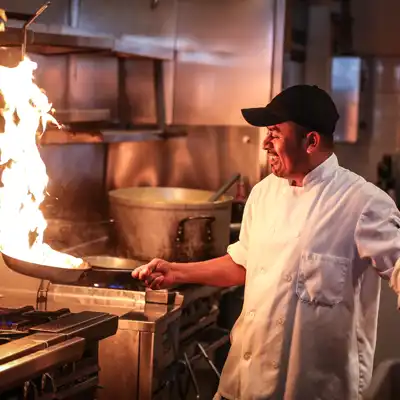Peanut butter and jelly sandwiches are a staple of many American children's diets. Yet if you have a peanut allergy, it’s a terrifying treat to encounter. Living with food allergies can be tough, and staying safe and healthy when you travel can be even more challenging.
The U.S. Food and Drug Administration recognizes nine categories of food allergens, but just six of them – milk, eggs, peanuts, tree nuts, soy, and wheat – account for 90% of food allergies in children. Ninety percent of food allergies in adults are caused by foods in only four of those categories, specifically peanuts, tree nuts, fish, and shellfish.
These allergies can be quite severe, sometimes even resulting in death if they cause a restriction of breathing. This is why many organizations, including some airlines, consider food allergies a disability.
It’s important to recognize that, depending on the allergy and its severity, the individual may not even need to ingest the food to have a reaction. Inhaling peanut dust, for example, or touching something with residue from the food can be enough to get hives, swelling in their mouth or eyes, or worse.
This begs the question: how do you deal with food allergies while traveling? Can you avoid peanuts, a snack that’s almost synonymous with air travel, during a flight? How do you find out what type of cooking oil is used at a restaurant when you’re traveling in another country?
Knowing the answers is vital to a successful and healthy trip.
Traveling with a Food Allergy: Before Departure
1. Visit your doctor.
Update and refill prescriptions. If you use an EpiPen, make sure you have at least two. Talk to your doctor about important steps to take during your trip to help you avoid an allergic reaction as well as what to do if you have one. Ask about the availability of telehealth appointments should you need one from the road.
2. Research restaurants.
Trying the local cuisine is a highlight of travel. With a food allergy, however, this can obviously get tricky. Research restaurants at your destination that have a good reputation for providing accommodations to those with allergies. If you really want to try a restaurant or food and you’re not sure if it’s safe, contact them ahead of time and ask about substitutions.
Reach out to groups located at your destination for dining recommendations. This could be a medical or advocacy organization or even a Facebook group. As locals, they should know the best places to eat, both because they’re delicious and safe for your allergy.
3. Make special requests with your travel providers.
If you didn’t contact them when you booked your trip, talk to your airline, cruise line, or hotel to let them know your dietary restrictions and if you need any additional assistance. Some of these companies are happy to accommodate your needs as long as they have advanced warning.
Even when you’ve already noted on your reservation that you have a food allergy, it may be helpful to call a few days before your arrival to confirm that they received instructions.
4. Locate emergency medical services.
When you have frequent or severe reactions, it’s important to know where the nearest hospital is. If you’re taking a road trip, research hospitals at each of the stops along your driving route, not just your final destination.
At a minimum, know how to contact emergency personnel. This should be simple to figure out if you’re traveling in your home country — calling 911 gets you the same result on your vacation in Sacramento as it does in your hometown of Schenectady — but different countries use different phone numbers for emergencies.
Create and communicate your emergency plan ahead of time so travel companions know what to do if you get sick.
5. Get an app.
AllergyEats lets you search for restaurants nearby, filtering for the type of allergy you have. It only lists places in the U.S., but you will find restaurant reviews from others with food allergies.
Allergy Force works internationally and can help you manage your food allergy by scanning barcodes to learn more about ingredients, tracking medication instructions and expirations, and sending messages to emergency contacts automatically. Among its other features is a digital chef card — more on these in a bit — that can be translated to 21 languages and sent to a restaurant via email or text as well as be saved on your phone so you can show it at the restaurant.
Food Allergies and Traveling Abroad
Communication is key when managing a food allergy when you travel. So when your trip takes you overseas and there’s a language difference, not to mention unfamiliar foods, you may encounter new challenges. There are many strategies for success. These three tips will help get you started.
1. Learn how to speak about your allergy.
Try to learn the name of your allergy and how to say some of the foods you avoid in the destination’s language. This will help you order with more confidence at restaurants. You should also learn how to identify the name of your allergy or “danger” foods by sight in the other language. This will help you when reading a menu or a label at the grocery store.
2. Learn the different names of foods.
Even when you’re traveling somewhere that speaks the same language, remember that there can still be differences in dialects. A zucchini in the United States is a courgette in England. Even more confusing is that what Australians call a pumpkin is a butternut squash to Americans.
Similarly, warnings on food labels may differ. An American label, for example, may simply warn about shellfish. But in New Zealand, they make a distinction between crustaceans and mollusks. And whereas New Zealand identifies lupin as a major food allergen, some Americans might not even know what that is. (It’s a bean.)
3. Pre-make chef cards.
A chef card looks a bit like a business card and clearly states what you cannot eat. They’re called chef cards with the idea that they can be given directly to the person preparing your food, and you don’t have to risk the message getting confused somewhere between the table when you ordered and the kitchen.
Be specific on the cards about the foods that you are allergic to. Rather than simply writing, “I have a dairy allergy,” try “I cannot eat milk, cheese, or cream due to a food allergy.” And whatever you choose to write on the card, do it in the language of your destination. Ask a bilingual native speaker or (cautiously) use Google Translate if you need help.
Food Allergies and Air Travel
Flying with a food allergy can create a lot of anxiety. You don’t have control over what food is served, you can't pick who’s going to sit next to and what they’re going to eat or do, and beyond the in-flight first aid kit, you won’t have immediate access to emergency medical care.
In most cases, these things shouldn’t prohibit you from flying, though. There are plenty of actions you can take before and during your flight to help you travel safely.
1. Choose your airline carefully.
Fortunately, airlines are taking food allergies more seriously. That being said, allergy policies can vary widely by airline. They may not view it as a disability and, therefore, not permit pre-boarding if you want to clean the area around your seat. Regardless of the policy on their website, though, it can’t hurt to ask for pre-boarding status.
If you self-identify that you have a food allergy, a few airlines will make an announcement asking all passengers to refrain from eating that food. Most others help you with seating by creating a “buffer zone.” This is usually a few rows in which they ask those sitting closest to you to also avoid eating foods that can cause you to have a reaction.
This happened to me not too long ago. When I got to my seat, the flight attendant discreetly mentioned that the person next to me had a nut allergy. She asked if I minded not eating peanuts, but if that was a problem, they would re-seat me. I stashed my trail mix in the overhead bin and munched on the provided pretzels instead.
According to their allergy policies, U.S. airlines like Delta and Southwest will not serve peanuts if the passenger makes that request at least 48 hours in advance. They will also allow you to pre-board to sanitize your seat. JetBlue also has a high reputation for accommodating passengers with food allergies, in part because crew members are certified in using epinephrine pens.
Some of the non-U.S. carriers with high reputations include Swiss Airlines, KLM, and British Airlines. Each will make special food arrangements if you alert them in advance. Swiss Airlines will also request that other passengers not bring snacks with your allergen onto the plane (I would have had to leave my trail mix behind completely had I been on Swiss Air), while KLM provides wipes after serving snacks so that all passengers can clean their area immediately.
2. Fly early in the morning.
The cleanest flight is the first flight of the day. While airlines do clean the planes between flights, the most thorough cleaning usually happens after the last one. If you’re worried about peanut dust or food residue, book an early-morning departure.
3. Bring your own food.
Some airlines have stopped serving peanuts completely, while others will avoid serving them if they know ahead of time that you have a peanut or tree nut allergy. Note that sometimes the alternative snack is cheese crackers, so if you also have a dairy allergy, this obviously won’t work for you.
Airlines can also provide alternative meal service with advance notification. However, mix-ups can happen. Your alternative meal might not make it on the plane. Staff might not know all the ingredients in a meal or snack. Or they might not know how it was prepared.
You can avoid all these potential pitfalls by bringing your own food either from home or by purchasing it at the airport where food is more likely to be clearly labeled. If you pack it from home, make sure it meets TSA requirements for security.
4. Ask for additional assistance.
When you book your flight online, some airlines will allow you to enter special instructions as part of your reservation. This is where you can enter what food allergy you have and if you require special meals, pre-boarding, a buffer zone or special seating, or other accommodations.
If there are any concerns about whether these accommodations can be carried out, call the airline at least a few days before your flight to confirm.
5. Keep medications with you.
Never put your medications in your checked luggage. Particularly with food allergies, when quick action is vital during a reaction, you need to have your medication within reach. Some experts don’t even recommend putting your medication in the overhead bin. Have it with you in your seat instead.
When going through security, remember that medically necessary liquids are permissible, and they don't need to follow the ounce limit. Make sure your medication is clearly labeled, and have a note from your doctor in case TSA asks for proof or documentation. This all applies to EpiPens as well.
While TSA will allow your medication through the checkpoint, they may ask to do an additional search. Check out TSA’s list of medical items you can carry on, which ones must be checked, and what may not be permitted at all.
If there’s a chance you’ll need help administering the medication, make sure your travel companions know what the symptoms of an allergic reaction are, where your medication is, and how to use it.
6. Sanitize anything you might touch.
Whether you’re able to pre-board or not, take a few minutes to clean your seating area. This includes using disinfectant wipes to sanitize arm rests, tray tables, windows and shades, and overhead air vents, lights, and call buttons.
Some food-allergic travelers also recommend covering your seat with your own blanket and using a large handkerchief or placemat on your tray table. And while we’re talking about blankets, you might make it a habit to always bring your own, as well as a pillow, since those don’t always get thoroughly cleaned between uses.
Food Allergies and Cruises
Cruises are generally known for their high levels of accessibility for travelers with disabilities, and that includes food-allergic passengers. Cruises are also known for their amazing dining experiences, which can prove to be daunting for some allergic passengers at first. Rest assured, though. It likely won’t be as difficult as it appears.
1. Book with cruise lines with a history of success with food allergies.
Just like airlines, some cruise lines have a better reputation than others with food-allergic passengers. For example, Celebrity Cruises has worked with Dine Aware since 2016 to help its staff better understand food allergies. Holland America also requires staff to be trained in cross-contamination prevention. A commitment to staff education can be a good indicator of the seriousness with which the company handles food allergies overall.
Carnival Cruises is another cruise line that gets high praise among those with allergies. The cruise line uses Menu Mate, a food ingredient app that identifies ingredients in menu options and then tells you which dishes can be modified to meet your requirements. By entering details about your restrictions in a tablet, you get important information about the menu and spend less time explaining your allergy to dining staff.
2. Make dietary requests early.
It’s rare to find a cruise ship that won’t accommodate dietary restrictions, whether for a food allergy, intolerance, or religious reason such as keeping kosher. They just need to know ahead of time. How far in advance differs from one cruise line to the next. The most extreme period we found was 90 days' notice. Other lines requested 30 or 45 days, while still others simply said to notify them at the time of booking.
Be sure to ask if any forms need to be completed to fulfill your dietary requests. This may be available on the cruise line’s website, although some request a faxed or emailed request.
3. Pick your restaurants wisely.
Just as you would research restaurants for a land-based trip, research the dining options on the ship. Even when a cruise line says it can accommodate special meals, those accommodations might only be available in the main dining room.
Although not unheard of, it’s rarer to find a ship that will make customized meals or serve them in-suite as part of room service.
Avoiding buffets is your safest option. Although some cruise lines said they can have a member of the dining staff prepare you a plate from the buffet, it’s still nearly impossible to guarantee there won’t be cross-contamination.
4. Learn about the dining process.
Sometimes you sit at the same table with the same fellow passengers and have the same waiters or waitresses the entire cruise. Other times, it’s different every day. Travelers with food allergies often find comfort in the cruise lines that offer consistency since you aren’t required to explain your food allergy to someone new each night.
If your cruise line allows you to select your meals the day before, either online or on a card, take advantage of this. It will give the staff more time to prepare a specialty meal if that’s what you require.
5. Ask about medical services on board.
Medical staff — whether it’s a doctor, nurses, or nurse practitioner — varies by ship. So does the availability of medications and whether the ship has a pharmacy. For this reason, it’s best to carry all medications, including EpiPens, with you on board.
This is one area where ocean liners differ greatly from river boats. River cruises rarely have a medical team.
While you’re asking about medical service on the ship, check whether you’ll be able to bring your medication with you on land when you dock for excursions. Some countries may not allow certain medications within their borders, or you may be required to carry certain documentation.
6. Beware of the food at ports.
Cruise lines can’t vouch for the safety of the foods you encounter at ports. Take the same precautionary measures during excursions as you would at home.
It’s also important to note that due to customs rules, some ports won’t allow you off the ship with your own snacks. Likewise, the ship may not let you back on board with food you purchased on land. This is particularly true of fruits, vegetables, and meats.
Food Allergies and Road Trips
In some ways, managing food allergies during a road trip is easier than it is when you fly. You’re somewhat contained by your own vehicle and not as dependent on the kindness of strangers. Still, you want to take steps to make sure your road trip goes off without a hitch.
1. Pack single-serving snacks.
Bringing your own food that you know to be safe is fairly obvious, but especially if you’re on a road trip with kids, put those snacks in single-serving bags. They’re easier to distribute and there’s less mess to clean (hopefully) than if you just hand them a full-size bag of treats.
In addition to fruits, vegetables, chips, and whatever else you like to snack on, be sure to include some high-protein options. These more filling foods will come in extra handy if you have to go a longer time between meals.
2. Have a picnic.
Again, this is all about having more control over ingredients. Instead of eating out for every meal, which we tend to do more when we travel, make picnicking a part of your itinerary.
Focus on shelf-stable foods that don’t need refrigeration, but if you have room in the car, pack a cooler. While we probably wouldn’t store lunch meat in there for days, a cooler is nice if you just need to preserve a sandwich or some yogurt for a few hours.
3. Choose the right lodging.
If you do plan to make your own meals, look for hotels that have a kitchenette. You can also book a vacation rental that comes with a fully stocked kitchen, which is ideal for longer trips. You’ll still need to go grocery shopping, but at least you won’t need to bring your own pasta strainer.
Depending on the severity of your allergy and how concerned you are about cross-contamination, take some time to thoroughly wash any kitchen utensils and surfaces before you use them. Your host should have taken care of it before your arrival, especially if you gave them notice of your allergy when you made your reservation. Better safe than sorry, though.
4. Bring your own towels.
If touching food residue or dust causes you to have an allergic reaction, consider bringing your own towels for the kitchen and bathroom. You’ll know how well they were cleaned before you need them.
In addition to towels, some travelers with severe food allergies also recommend using your own pillowcase and other bedding.
Pack some travel detergent and a sink stopper (not all hotels have them) if you plan to do laundry along the way, too. Some of the most common detergent brands you use at home also come in small travel sizes perfect for washing clothes or towels in the sink or bathtub. If you’re worried about spilling, try soap sheets instead.
What to Pack for Traveling with Food Allergies
We’ve hinted at some of these items already, but here’s your packing list for traveling with a food allergy. It might not all apply to you depending on how you’re traveling or the severity of your allergy, so choose what helps you be most comfortable on your next adventure.
- Medications, plus written and digital copies of prescriptions and other required documentation, especially when traveling abroad. Bring extra medication, if possible, in case of travel delays.
- “Safe” snacks and/or meals, packed in single-serving containers. Bring more than you think you need in case of travel delays.
- Travel silverware kit
- Chef cards in your destination’s language to explain your allergy to restaurant staff
- A blanket, pillow, and/or pillowcase
- Towels, including a bath towel, hand towels for the kitchen and/or bathroom, and washcloths
- Disinfectant wipes
- Laundry detergent
- List of emergency medical services nearby and phone numbers for emergency services
- Travel insurance
Food Allergies and Travel Insurance
You can get travel insurance, even if you have a food allergy. Depending on the plan you purchase and how you manage your allergy, that allergy may be considered a pre-existing condition. This is one reason we recommend buying travel insurance as soon as possible. Some parts of your plan, including the pre-existing condition waiver, are only available if you purchase your plan within a certain number of days after making your first trip payment.
Visit SevenCorners.com for a quick quote or contact our licensed agents if you have questions about the right plan for you and your next adventure.
Travel Like a Pro with The Wayfinder
Did you enjoy this blog? Get more articles like it before anyone else when you subscribe to our monthly newsletter, The Wayfinder.
Sign me up








